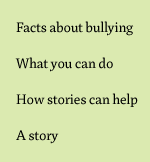 What You Can Do About Bullying A-Z
What You Can Do About Bullying A-Z
Here are some essential steps toward decreasing bullying and increasing safety in your school and classroom:
A) Identify with your students and faculty the many forms that bullying takes. Research has shown that this is best done by letting students and staff fill out anonymous surveys at least yearly.
B) From the surveys and group discussions generate a list of behaviors that are considered bullying and thus unacceptable.
C) Acknowledge that bullying does go on in every school, and identify the places and times where bullying happens most often in your school.
D) Acknowledge that bullying happens outside of school, and to identify those places and scenarios in your student's lives. This is important for many reasons, among them the fact that sometimes bullies at school are victims at home. Also I find that children most readily identify having been bullied by a sibling, relative or neighborhood child or relative.
E) Sensitize all students to the effects of bullying. Because so many aspects of bullying are social sanctioned the hurtful effects are often minimized by those who bully or those who observe bullying.
F) Help students to acknowledge and think about times in which they might have been involved with bullying as a bully.
G) Help students to acknowledge and think about times in which they might have been involved with bullying as a victim.
H) Acknowledge that every person who witnesses bullying; who laughs or plays along, is involved in bullying. This is called, "joining-in".
I) Discuss the challenges that students and teachers face in knowing how to speak up when bullying is happening.
J) Empower students and faculty with the communication tools and confidence to speak out against bullying, and help to stop it when it is happening. Research has shown that it is effective to have a Bully Officer to report to that is separate from the chief disciplinarian (usually the assistant principal). The students will have greater sense that their efforts will be heard, and less fear that the result will be punitive.
K) Have clear and enforceable consequences for bullying behaviors.
L) Support victims of bullying and their families in finding healthy ways to cope with and to respond to bullying. Blaming the victim or working to help the victim change their behaviors is rarely helpful, and mostly harmful.
M) Work supportively with bullies and their families to address underlying causes of this behavior. Often it is necessary to involve a professionally trained counselor as there are usually problems in the family system, and parents can be defensive.
N) Educate every parent in the school community about the bullying policy. Some parents still tell their children to, "ignore it," or even to "hit back" when they are bullied. You can help them to be more supportive in productive ways.
O) Focus on ways to strengthen the sense of community identity within the school. This helps students to feel safe, and connected to one another and responsible for one another.
P) Teach kids how to recognize the difference between assertive and aggressive styles of communication. Help them to learn the tools of assertiveness through identifying the differences and practicing assertive means of asking for what you need and expressing your feelings. Many kids, who are bullied, end up responding with aggressive means for lack of better training or skills.
Q) Teach anger management techniques. This involves becoming more sensitive to feelings of anger, recognizing them before they are too strong, and learning safe ways to expressing anger, and expressing your needs and feelings.
R) With younger students it is important to teach the difference between "tattling" and telling. When we tattle we are trying to get someone into trouble. When we tell, we are trying to prevent trouble. Create scenarios to discuss this and bring it up every time there is a question. Tattling can be a form of subtle bullying in young children.
S) Teach the difference between teasing and bullying. It has to do with the intent of the behavior. Is it meant to intimidate or hurt another? Is merely an affectionate way of being silly? Does it hurt the person it is directed towards? Is a way to have power and control over another? Is it meant to point out one person's differences in a way that would ostracize them?
T) Talk about joking and when jokes are funny and when they are mean. Black humor is always aimed at someone else's expense. It is a put down. White humor is just meant to be funny without hurting anyone. Help students to be more sensitive to when and why they laugh. Often we respond to something that makes us uncomfortable with nervous laughter.
U) Train everyone in the school community, including bus drivers, cafeteria and recess monitors and substitute teachers.
V) Create opportunities for students to know those outside of their immediate peer group beyond superficial stereotypes.
W) Foster opportunities for cooperative efforts at school.
X) Reward victims for speaking up about their abuse.
Y) Reward bystanders for speaking up on the behalf of victims.
Z) Reward bullies for learning and practicing new behaviors at school.